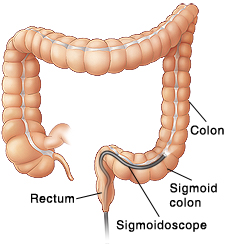When Your Child Needs a Colonoscopy or Sigmoidoscopy
When Your Child Needs a Colonoscopy or Sigmoidoscopy
A colonoscopy is a test that allows the doctor to look inside the colon and rectum. A sigmoidoscopy is a shorter version of this test that only includes the lower part of the colon, called the sigmoid colon, and the rectum. The doctor may take tissue samples (biopsy), and check for tissue growths (polyps) or bleeding. The time needed for the test will depend on how clean the colon is, the condition, and the treatment necessary. In general, colonoscopy takes about 30 minutes and sigmoidoscopy takes about 10 to 15 minutes.
|
Before the Test
Your child’s colon may need to be cleaned out before the test. Follow any instructions given by the doctor. These may include:
Have your child drink a liquid bowel prep before the test.
Switch your child to a clear liquid diet 1 to 2 days before the test.
Give your child a laxative, a suppository, or enema the night before and on the day of the test.
Let the doctor know
For your child’s safety, let the doctor know if your child has any of the following:
Allergies to any medicine, sedative, or anesthesia
Heart or lung problems
Takes any medicines, especially aspirin
During the test
A colonoscopy or sigmoidoscopy is done by a doctor in an office, testing center, or hospital.
You can stay with your child in the testing room until your child falls asleep or the test begins.
Your child lies on an exam table on his or her left side.
Your child is given a pain reliever and medicine that makes your child sleepy (sedative). This is done through an IV line. Or your child is given medicine that makes your child sleep (anesthesia) by facemask or IV. A trained nurse or anesthesiologist helps with this process and also monitors your child. Special equipment is used to check your child’s heart rate, blood pressure, and blood oxygen levels. Sigmoidoscopy usually doesn’t require your child to be sedated.
The doctor inserts a colonoscope or sigmoidoscope into your child’s rectum and colon. This is a long, flexible tube with a camera and a light at the end. During a sigmoidoscopy, the scope will only advance through the sigmoid colon. It will sometimes travel a bit farther if the view is clear and the child is comfortable.
Air is pushed through the scope to expand your child’s lower GI tract. Water may also be used to clean the colon.
Images of your child’s colon are viewed on a screen as the scope moves along.
The doctor may take tissue samples and remove any polyps that are found.
After the test
When the test is done, you can expect the following:
If a sedative or anesthesia was given, your child is taken to a recovery room. It may take 1 to 2 hours for the medicine to wear off.
Your child can return to his or her normal routine and diet right away, unless told otherwise.
The doctor may discuss early results with you after the test. You’re given complete results when they’re ready.
Helping your child get ready
You can help your child by preparing in advance. How you do this depends on your child’s needs. Try the following:
Explain that the doctor will be testing the colon and rectum. Use brief and simple terms to describe the test. Younger children have shorter attention spans, so do this shortly before the test. Older children can be given more time to understand the test in advance.
As best you can, describe how the test will feel. An IV may be inserted into the arm to give medicines. This may cause a little sting. Your child won’t feel anything once the medicines take effect.
If your child is not sedated then mild cramping is common.
Allow your child to ask questions.
Use play when helpful. This can involve role-playing with a child’s favorite toy or object. It may help older children to see pictures of what happens during the test.
When to call your child’s doctor
Call your doctor if your child has any of the following:
Abdominal pain, nausea, or vomiting
A large amount of blood in the stool right after the test or blood in the stool for several days
Persistent fever over 100.4°F (38.0°C), or as directed by your healthcare provider
Updated:
September 29, 2017
Reviewed By:
Bass, Pat F. III, MD, MPH,Lehrer, Jenifer, MD

